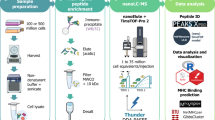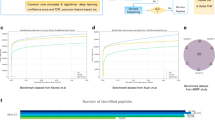Abstract
Developing a deep and comprehensive understanding of the collection of peptides presented by class I human leukocyte antigens (HLA ), collectively referred to as the immunopeptidome , is conducive to the success of a wide range of immunotherapies. The development of tools that enable the deconvolution of immunopeptidomes in the context of disease can help improve the specificity and effectiveness of therapeutic strategies targeting these peptides, such as adoptive T-cell therapy and vaccines. Here, we describe a computational workflow that facilitates the processing and interpretation of data-independent acquisition mass spectrometry (DIA-MS). We consider a specific variation of DIA-MS known as SWATH-MS. SWATH-MS is a promising technique that can be utilized to reproducibly characterize and quantify immunopeptidomes isolated from a wide range of biological sources. In this workflow, we use an assortment of database search engines and computational tools to build high-quality HLA allele-specific peptide spectral peptide libraries for the analysis of immunopeptidomic datasets acquired by SWATH-MS. Generating and sharing these spectral libraries are essential for the SWATH-MS technology to meet its full potential and to enable the rapid and reproducible quantification of HLA-specific peptides across multiple samples.
Access this chapter
Tax calculation will be finalised at checkout
Purchases are for personal use only
Similar content being viewed by others
References
Koff WC, Burton DR, Johnson PR et al (2013) Accelerating next-generation vaccine development for global. Clin Infect Dis 340. https://doi.org/10.1126/science.1232910
Yi L, WEIFAN Y, HUAN Y (2019) Chimeric antigen receptor–engineered regulatory T lymphocytes: promise for immunotherapy of autoimmune disease. Cytotherapy 21:925–934. https://doi.org/10.1016/j.jcyt.2019.04.060
Bräunlein E, Krackhardt AM (2017) Identification and characterization of Neoantigens as well as respective immune responses in cancer patients. Front Immunol 8:1702. https://doi.org/10.3389/fimmu.2017.01702
Caron E, Vincent K, Fortier M et al (2011) The MHC I immunopeptidome conveys to the cell surface an integrative view of cellular regulation. Mol Syst Biol 7:533. https://doi.org/10.1038/msb.2011.68
Kowalewski DJ, Schuster H, Backert L et al (2015) HLA ligandome analysis identifies the underlying specificities of spontaneous antileukemia immune responses in chronic lymphocytic leukemia (CLL). Proc Natl Acad Sci U S A 112:E166–E175. https://doi.org/10.1073/pnas.1416389112
Falk K, Rötzschke O, Stevanovié S et al (1991) Allele-specific motifs revealed by sequencing of self-peptides eluted from MHC molecules. Nature 351:290–296. https://doi.org/10.1038/351290a0
Hunt DF, Henderson RA, Shabanowitz J et al (1992) Characterization of peptides bound to the class I MHC molecule HLA-A2.1 by mass spectrometry. Science 255(5049):1261–1263. https://doi.org/10.1126/science.1546328
Admon A, Bassani-Sternberg M (2011) The human Immunopeptidome project, a suggestion for yet another Postgenome next big thing. Mol Cell Proteomics 10:O111.011833. https://doi.org/10.1074/mcp.o111.011833
Granados DP, Laumont CM, Thibault P, Perreault C (2015) The nature of self for T cells—a systems-level perspective. Curr Opin Immunol 34:1–8. https://doi.org/10.1016/j.coi.2014.10.012
Michalski A, Cox J, Mann M (2011) More than 100,000 detectable peptide species elute in single shotgun proteomics runs but the majority is inaccessible to data-dependent LC−MS/MS. J Proteome Res 10:1785–1793. https://doi.org/10.1021/pr101060v
Gillet LC, Navarro P, Tate S et al (2012) Targeted data extraction of the MS/MS spectra generated by data-independent acquisition: a new concept for consistent and accurate proteome analysis*. Mol Cell Proteomics 11:O111.016717. https://doi.org/10.1074/mcp.o111.016717
Caron E, Espona L, Kowalewski DJ et al (2015) An open-source computational and data resource to analyze digital maps of immunopeptidomes. Elife 4:e07661. https://doi.org/10.7554/elife.07661
Deutsch EW, Mendoza L, Shteynberg D et al (2015) Trans-proteomic pipeline, a standardized data processing pipeline for large-scale reproducible proteomics informatics. Proteomics Clin Appl 9:745–754. https://doi.org/10.1002/prca.201400164
Reynisson B, Alvarez B, Paul S et al (2020) NetMHCpan-4.1 and NetMHCIIpan-4.0: improved predictions of MHC antigen presentation by concurrent motif deconvolution and integration of MS MHC eluted ligand data. Nucleic Acids Res 48:gkaa379. https://doi.org/10.1093/nar/gkaa379
Röst HL, Rosenberger G, Navarro P et al (2014) OpenSWATH enables automated, targeted analysis of data-independent acquisition MS data. Nat Biotechnol 32:219–223. https://doi.org/10.1038/nbt.2841
Röst HL, Sachsenberg T, Aiche S et al (2016) OpenMS: a flexible open-source software platform for mass spectrometry data analysis. Nat Methods 13:741–748. https://doi.org/10.1038/nmeth.3959
Chambers MC, Maclean B, Burke R et al (2012) A cross-platform toolkit for mass spectrometry and proteomics. Nat Biotechnol 30:918–920. https://doi.org/10.1038/nbt.2377
Keller A, Nesvizhskii AI, Kolker E, Aebersold R (2002) Empirical statistical model to estimate the accuracy of peptide identifications made by MS/MS and database search. Anal Chem 74:5383–5392. https://doi.org/10.1021/ac025747h
Shteynberg D, Deutsch EW, Lam H et al (2011) iProphet: multi-level integrative analysis of shotgun proteomic data improves peptide and protein identification rates and error estimates. Mol Cell Proteomics 10:M111.007690. https://doi.org/10.1074/mcp.m111.007690
Lam H, Deutsch EW, Eddes JS et al (2007) Development and validation of a spectral library searching method for peptide identification from MS/MS. Proteomics 7:655–667. https://doi.org/10.1002/pmic.200600625
Acknowledgments
We thank all members of the Caron Lab for helpful discussions. This work was supported by funding from the Fonds de recherche du Québec—Santé (FRQS), the Cole Foundation, CHU Sainte-Justine and the Charles-Bruneau Foundations, Canada Foundation for Innovation, and by the National Sciences and Engineering Research Council (NSERC) (#RGPIN-2020-05232). K.K. is a recipient of IVADO’s postdoctoral scholarship (#4879287150). E.C. is a FRQS Junior 1 Research Scholar.
Author information
Authors and Affiliations
Corresponding author
Editor information
Editors and Affiliations
Rights and permissions
Copyright information
© 2022 The Author(s), under exclusive license to Springer Science+Business Media, LLC, part of Springer Nature
About this protocol
Cite this protocol
Kovalchik, K., Hamelin, D., Caron, E. (2022). Generation of HLA Allele-Specific Spectral Libraries to Identify and Quantify Immunopeptidomes by SWATH/DIA-MS. In: Corrales, F.J., Paradela, A., Marcilla, M. (eds) Clinical Proteomics. Methods in Molecular Biology, vol 2420. Humana, New York, NY. https://doi.org/10.1007/978-1-0716-1936-0_11
Download citation
DOI: https://doi.org/10.1007/978-1-0716-1936-0_11
Published:
Publisher Name: Humana, New York, NY
Print ISBN: 978-1-0716-1935-3
Online ISBN: 978-1-0716-1936-0
eBook Packages: Springer Protocols




